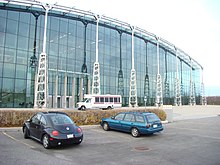Library and Archives Canada
| Public Archives and National Library Building Édifice de la Bibliothèque et des Archives nationales |
|
|---|---|
|
Historic Place of Canada Lieu patrimonial du Canada |
|
| Recognized since | 2004 |
| Type | Classified Federal Heritage Building |
| ID | 13053 |
| place | Ottawa |
| Coordinates | 45 ° 25 '10.7 " N , 75 ° 42' 28.1" W |
| Recognized by | Canadian Federal Government |
| Approved by | Treasury Board Heritage Buildings Policy |
| Entry Canadian List of Monuments | |
Library and Archives Canada ( French Bibliothèque et Archives Canada ; German Library and Archives Canada ) is the national library of Canada . The founding year was 1953. In 2003 the National Library of Canada and the National Archives of Canada merged. It is one of the largest libraries in the world .
Your main task is to collect and preserve Canadian history in the form of texts and images . These are provided by government departments, national groups or organizations and private individuals.
The main building was opened on June 20, 1967 by Prime Minister Lester B. Pearson . Since the merger in 2002, over 1100 employees have been working there.
The service building is located in Ottawa , close to other important Canadian buildings such as Parliament Hill and the Supreme Court of Canada .
The sculpture The Secret Bench of Knowledge by Lea Vivot is placed in front of the main entrance .
All-Canadian OPAC since 2018
Since February 2018 Bibliothèque et Archives Canada has created a new OPAC that can be accessed online worldwide. It's called the National Union Catalog - Voilà. Catalog collectif national - Canada's Catalog and lists all works in Canada's public or university libraries; the data sets are based on the OCLC system.
Optionally, worldwide library entries can also be called up by ticking the box; in this case it is not necessary that the factory be located in Canada.
With this OPAC, the research of literature that is in any way related to Canada has become much easier and faster than before; the new standard corresponds to that of other national libraries . If necessary, the language in which an author was published and of which at least one copy is available in Canada can be selected in the sitemap. If a user wishes the instructions for use either in English or in French, he must access the Bibliothèque et Archives Canada , on whose website one of the two languages can be selected. The information on a specific book or other medium is always written in the language in which the medium in question is written. Access is via the special Voilà page linked here, or via the Bibliothèque et Archives Canada . Journal articles are also displayed if they have been indexed in a library in Canada.
There are full texts link if one of the member libraries own the rights to it and can pass on these rights ( open source ), for example. B. the French Érudit system. The same goes for image documents; For example , a video from Société Radio-Canada by Wajdi Mouawad can be viewed online.
Since the US and Canadian book markets are closely linked, namely economically at the publishing level, primarily in relation to the English language , Voilà also offers to a certain extent the possibility of US printed products, reviews in US newspapers or people who are based in both countries.
Just as the German National Library thinks, the Canadian OPAC reaches its limits, even with an extended search if an author's name or another search term contains overly popular terms, e.g. B. in the search for Thomas King .
See also
Web links
- Official website (English; French)
- Hans-Jürgen Huebner: Library and Archives Canada
Footnotes
- ↑ https://www.bac-lac.gc.ca/eng/transparency/atip/info-source/Pages/infosource.aspx
- ↑ Research in "Voilà" , here using Margaret Atwood as an example (there are 5312 results in both language versions); another version WITHOUT "638": [1] using the example of the translator Sonja Finck



